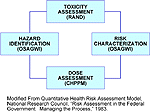
To estimate the health risks from exposures to toxic substances, the DoD adopted a health risk assessment methodology based on that used by the US Environmental Protection Agency. This process, illustrated in Figure D-1, estimates the health risks from exposure to contaminant concentrations and contaminated sites, and the health risks from the contaminant's toxicity characteristics. It consists of four steps: hazard identification, dose assessment, toxicity assessment, and risk characterization.
Figure D-1. Health risk assessment process
Hazard identification determines who was exposed and how -- including the identification of: a) the possible contaminants (in this case, DU); b) the individuals exposed to that contaminant; c) the exposure pathways (e.g., inhalation); and d) which incidents need to be evaluated. Dose assessment estimates the intensity, frequency, and duration of exposures to DU and what chemical and radiological intakes these doses represent. Toxicity assessment involves researching the medical effects of exposure to DU and at what levels of exposure these effects might start to occur. Risk characterization is the "bottom line" of the health risk methodology. Using both dose-assessment and toxicity assessment data, the risk assessment provides an explanation of the health risk from a given activity or exposure scenario. To arrive at this assessment, the Office of the Special Assistant for Gulf War Illnesses (OSAGWI) developed an investigation and validation process that includes:
Performing this assessment for DU involves the cooperative efforts of several organizations:
| First Page | Prev Page | Next Page |